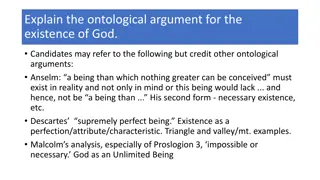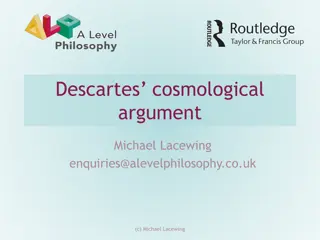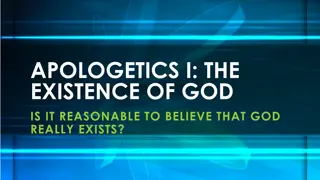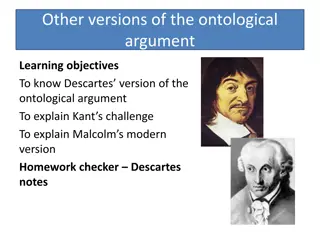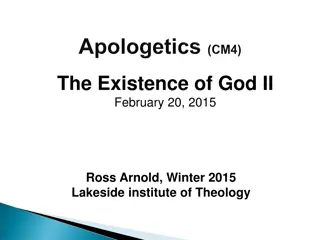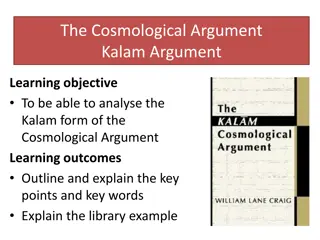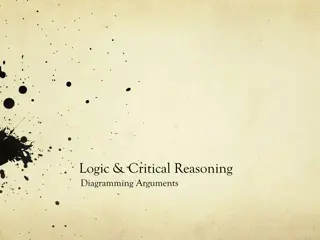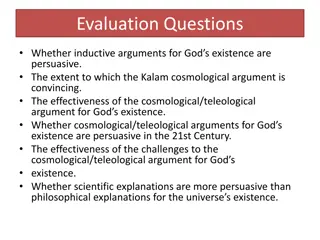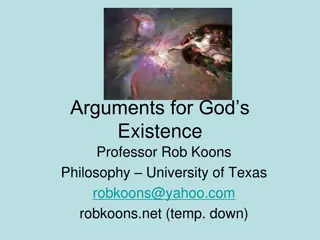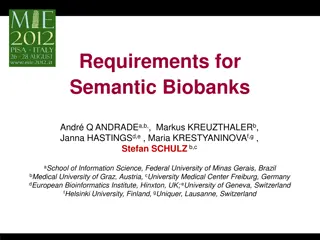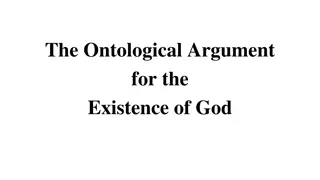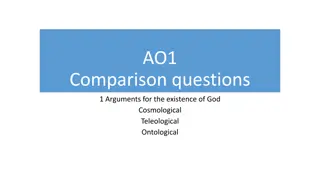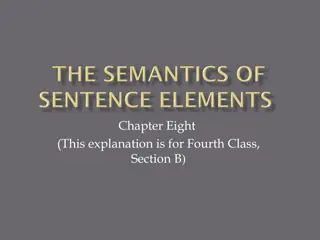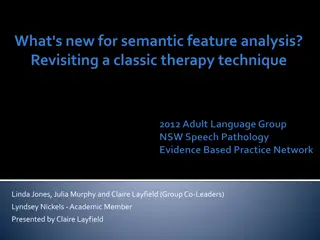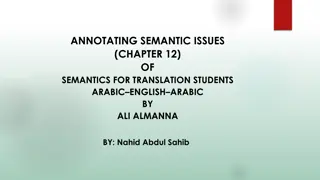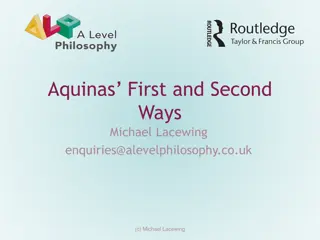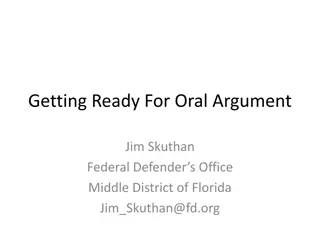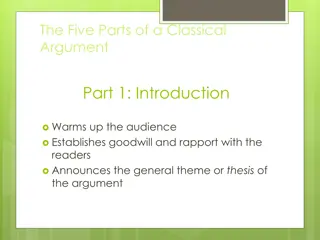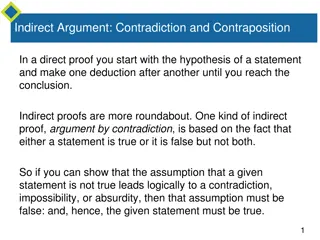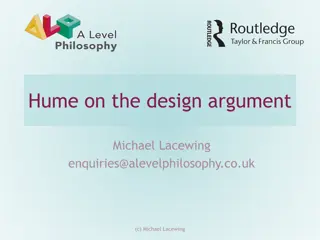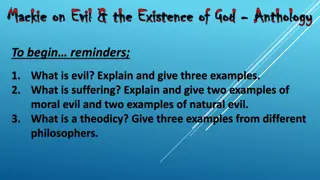The Semantic Argument for the Existence of God - International Conference Insights
Explore the Semantic Argument and its implications for the existence of God as presented by Emanuel Rutten at the International Proofs of God's Existence Conference. The lecture delves into universal properties, formal versus non-formal properties, and the likelihood of God's existence based on these arguments.
Download Presentation

Please find below an Image/Link to download the presentation.
The content on the website is provided AS IS for your information and personal use only. It may not be sold, licensed, or shared on other websites without obtaining consent from the author. Download presentation by click this link. If you encounter any issues during the download, it is possible that the publisher has removed the file from their server.
E N D
Presentation Transcript
The Semantic Argument and its implications for the likelihood of the Existence of God International Proofs of God s Existence Conference organized by the Science Philosophy Religion Foundation Istanbul | Spring 2023 Emanuel Rutten VU Amsterdam e.rutten@vu.nl
Objective of this lecture A universal property is a property that everything that exists has. Examples include such formal properties as being an object or being identical to itself . I will define formal in what follows. The semantic argument (Rutten 2021) is an argument for the claim that there are no universal non-formal properties. For each non- formal property there exists an object that lacks that property. In this lecture I present my semantic argument and I show how its conclusion renders it likely or at least significantly increases the likelihood that God exists. God is understood as a personal being that is the first cause of the world. God is a personal first cause. I start with initial stage setting.
Stage setting An object is something that exists, such as a table, an electron, a tree, a tiger, a human being and God (if God exists). Objects have properties. John is a man and John s bike is red. A property is formal if and only if all objects in all possible worlds have it. Being an object and being self-identical are formal properties. For all objects in all possible worlds are objects and identical to themselves. Being a man and being red are non-formal properties. The claim that there are no universal non-formal properties amounts to the following. If property p is such that some object in some possible world lacks p, then there is an object in the actual world that lacks p. I claim modal collapse for lackings : Possible lackings are actual lackings.
Stage setting (cont.) Negative properties (e.g., Being not red ) and relational properties (e.g., Being located north of Paris ) are excluded. So it s more exactly claimed that there are no universal non-formal positive intrinsic properties. Each property (e.g., Being red ) corresponds to a concept( Red ). Each concept has a reference (e.g., all red objects). Two concepts are identical if and only if they have the same meaning(e.g., Object and Entity ). A complexconcept (e.g., Unicorn , Vixen or Red table ) consists of sub- concepts( Horn , Forehead & Horse ; Female & Fox ; Red & Table ). A simple concept is a concept that is not complex (e.g., Red or Object ). Subconcepts can themselves be either simple or complex. Hence we can recursively unfold a complex concept into a collection of simple concepts.
Stage setting (cont.) In addition to a reference, concepts also have a reference set. The reference set of a simple concept is the reference of that concept. The reference set of Red is (its reference and thus) the set of all red objects. The reference set of a complex concept is the union of the references of its subconcepts. The reference set of Red bike is the set of all red objects and all bikes. It contains red tables and blue bikes. The reference set of Vixen is the set of all females and all foxes. Different concepts can have the same reference (as Frege has taught us). Animals having a heart and Animals having a kidney are different concepts. They have a different meaning. Yet, each animal that has a heart has a kidney and vice versa. Different concepts cannot have the same reference set (as I claim). Animals having a heart and Animals having a kidney indeed have different reference sets. For heart is a subconcept of the former and not of the latter. So the reference set of the former includes all hearts, whereas the reference set of the latter doesn t.
The semantic arguments core premise If two concepts have the same reference set, then they are identical (semantic argument s core premise). Sameness of reference does not guarantee sameness of meaning. But sameness of reference sets does guarantee sameness of meaning. If two concepts have the same reference set, then those concepts cannot be distinguished from each other by tracing the references of their sub- concepts. Both concepts reach out to the world s objects in the same manner. This substantiates the assertion that they are in fact identical. Moreover, numerous alleged counterexamples of different concepts having the same reference set have been refuted (Rutten 2021). The core premise of the semantic argument thus has a relatively high corroboration rate.
The semantic argument stated Suppose for reductio ad absurdum that there is a non-formal universal property p. Let P be the concept that corresponds to p. Since p is universal, the reference of P is everything that exists. Concept P is either simple or complex. If P is simple, then the reference set of P (being the reference of P) is everything that exists. The concept Object is simple. The reference set of Object (being the reference of Object ) is the collection of all objects. That is to say, it s everything that exists. Since P and Object have the same reference set, P and Object have the same meaning. P is identical to Object . But then p is the property of Being an object . Yet p is supposed to be a non-formal property. We arrive at a contradiction.
The semantic argument stated (cont.) If P is complex, then P is the conjunction of two or more simple subconcepts. Since P corresponds to universal property p, the reference of P is everything that exists. But then, since P is a conjunction of simple subconcepts, the reference of each simple subconcept of P is also everything that exists. The reference set of each simple subconcept of P (being the reference of that subconcept) is also everything that exists. So, again, since the reference set of Object is also everything that exists, it follows that each simple subconcept of P has the same meaning as Object and is therefore identical to Object . But then P is the conjunction of two or more concepts that are all identical to Object . Hence P is identical to Object and p is the property of Being an object . Yet p is supposed to be a non-formal property. We arrive again at a contradiction. We thus obtain the conclusion that there are no non-formal universal properties.
The weight of tradition: there are no universal properties if reality is grounded in opposites Throughout history, philosophers from various traditions have affirmed that reality is grounded in opposites. But then there are no universal properties. Heraclitus teaches that nature is a harmony or unity of opposites. For everything that exists, its opposite also exists. Aristotle affirms in his On the Cosmos that nature loves opposites. And in his Rhetoric he asserts that if something is possible, its opposite is also possible. Cicero argues in his On the Nature of the Gods that nature is constructed in such a way that everything has its opposite. Cicero notes that this was also the view of Epicurus, who called it the principle of isonomia or equal distribution. Spinoza asserts Determinatio negatio est. Determination is negation. To exist, to be determined, is to negate. For something to exist, its opposite must also exist. In his dialectics Hegel affirms the principle that reality unfolds through opposites. Many speculative postmodernists hold that reality is grounded in differences.
Implications of there being no universal properties Not everything is water (refuting Thales), fire, earth, a monad (refuting Leibniz), will to power (refuting Nietzsche) or will to live (refuting Schopenhauer). Being material is not a universal property. So not everything is material. There are non-material or immaterial objects. So materialism fails. Being physical and Being natural are not universal properties either. There are non-physical and super-natural objects. Physicalism and naturalism fail. Being immanent is not a universal property either. So there must be a transcendent realm of transcendent objects. Immanentism fails. Not everything is perishable. There are thus non-perishable, everlasting or eternal objects. And not everything is finite. So there are infinite objects. Panpsychism fails as well. For not everything has a mental aspect. There are objects without a mental aspect. Empiricism or positivism or phenomenalism fail as well. For Being observable is not a universal property either. Not everything is observable.
Implications of no universal properties (cont.) Pantheism also fails. For Being divine is not a universal property. Hence not everything is divine. Being mental is not a universal property either. Not everything is mental. So also metaphysical idealism fails. Solipsism fails as well because Being the only object in the world would be a universal property if solipsism were true. But there are no universal properties. The famous problem of the existence of the external world is therefore solved. Not everything is a concrete object. So there are abstract objects. We obtain as a corollary that Plato was in fact right after all to posit abstracta. Not everything is determined. So there are undetermined objects and thus there is genuine free will. For objective randomness is impossible (Rutten 2012). Not everything is contingent. So there exists a necessarily existing object. As a corollary we obtain a new ontological argument for there being a necessary being. Not everything is spatial or temporal. There are a-spatial and a-temportal objects.
Implications of no universal properties (cont.) Not everything that exists is actual. There exist non-actual objects. Hence mere possibilia indeed exist. Also, not everything is a composite of matter and form. So there are objects that exist as pure form as Aristotle and Aquinas assert. Not everything is good. So there must be objects that are not good. Evil exists. This corollary opens the pathway to a radically new and unforeseen theodicy. Not everything is caused. So there must be uncaused objects. Not everything is a mereological composite. So there are mereological simples. There are atoms. There is thus indeed a fundamental or ultimate level of reality. Even the famous question of Leibniz can be answered. Why is there something rather than nothing? The answer is that there must be objects. Because else all properties would be universal due to the logical principle of ex falso quodlibet. Reality contains immaterial, non-physical, supernatural, transcendent, necessarily existing, uncaused, abstract, free, eternal, infinite, a-spatial and a-temporal objects. This is incompatible with common atheistic worldviews. Those objects naturally fit with a worldview that is diametrically opposed to atheism: theism. The absence of universal properties therefore increases the likelihood of theism significantly.
Increasing the likelihood of theism By now the recipe for deriving further corollaries of interest to long-standing debates in metaphysics will be clear enough. There is an abundance of corollaries. The conclusion of the semantic argument (i.e., there are no universal properties) begins to reveal itself as a theory of everything. For the entire world as we have traditionally always known it throughout the ages seems to be implied by it. That single formula that is not ad hoc and adequately describes and explains the entire reality is not a formula within cosmology or physics. It is a formula within metaphysics, namely the proposition that there are no universal properties. The conclusion that there are no universal properties acts as a epistemic filter for worldviews. Monistic worldviews (i.e., worldviews relying on there being a universal property) such as materialism, physicalism, naturalism, immanentism, panpsychism, idealism, pantheism, vitalism, positivism and solipsism all fail. Only dualistic worldviews such as theism and Platonism survive the epistemic filter. But since Platonism effectively entails theism (Rutten 2021) reasonably theism remains as feasible or viable worldview.
Increasing the likelihood of theism (cont.) There are no universal properties. So being cannot be restricted. It always slips away from any compulsive "Everything is X" corset. That is to say, being cannot be squeezed into any universalist mold. Being is radically free. The ultimate truth of being is therefore freedom. Free at last. But freedom is grounded in subjectivity. Freedom is a characteristic of mind. The mind is free because it transcends any formalism. Dialectically speaking, mind always has the capacity for negation. The absence of universal properties hence reasonably suggests that the ultimate ground of the world is a free conscious being. So the ultimate ground of reality can reasonably be referred to as God. The semantic argument thus reveals the spiritual ground of the world and shows us the intimate connection between language, reality, and the metaphysical ultimate. It is no wonder that theism emerged as the most likely worldview in our linguistic analysis. For it is indeed language, word or logos, that ultimately points us to the ultimate origin of the world. For the world is the world as it is thought by logos.


